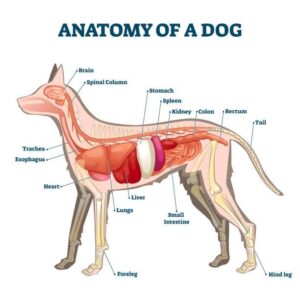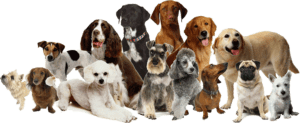Dogs are one of the most popular pets in the world. They’re loyal, affectionate, and adorable, but what do you know about your dog’s body type?
There are so many different breeds out there that it can take time to tell which one is right for you. Choosing a breed of dog is a very personal decision.
It would help if you found the right breed for your lifestyle, but other factors must also be considered.
Some dogs are great at protecting their owners from intruders, while others are better suited to play with kids in the backyard or go on long walks with their owners.
Luckily, this article will help you learn more about dog shapes, their health benefits, and behavior quirks!
The Anatomy of Dogs

Dogs are mammals and have a skeletal structure similar to that of humans. They have a head, neck, body, legs, and tail.
The head houses the brain and is composed of the skull and face. The face contains the eyes, ears, nose, and mouth.
The neck connects the head to the body and provides movement and flexibility. The body includes the chest, abdomen, and back, supported by the legs.
The legs include the hips, thighs, knees, and feet. The tail is an extension of the spine and can be used for communication and balance.
Dogs have a variety of internal organs, including the heart, lungs, liver, and kidneys. The heart pumps blood throughout the body, while the lungs provide oxygen to the bloodstream.
The liver filters toxins from the blood and aids digestion, while the kidneys filter waste products from the blood and help maintain electrolyte balance.
The digestive system includes the stomach, intestines, and anus and is responsible for breaking down food and absorbing nutrients.
The reproductive system includes the testes and ovaries and is responsible for producing and fertilizing eggs.
Overall, the anatomy of dogs is complex and includes a variety of specialized features essential to their health and well-being.
The Diversity of Dog Breeds

Dogs are one of the most diverse mammals, with hundreds of distinct breeds recognized by various organizations worldwide.
A breed is typically defined as a group of dogs with a common ancestry, physical appearance, and temperament.
Breeds can be classified based on their intended use or physical characteristics, such as size, coat type, and body shape.
The American Kennel Club (AKC) recognizes seven major breed groups: Sporting, Hound, Working, Terrier, Toy, Non-Sporting, and Herding.
The Sporting group includes breeds traditionally used for hunting, such as Labrador Retrievers and Golden Retrievers.
Hounds were bred for their excellent sense of smell and are used for tracking games. Working breeds were developed to perform tasks like pulling carts or guarding livestock, including breeds like Boxers and Great Danes.
Terriers are known for their high energy and tenacity and are often used for hunting vermin. The Toy group includes smaller breeds, such as Chihuahuas and Pomeranians, kept as companion animals.
Non-Sporting breeds are a diverse group of dogs that do not fit into the other categories, including the Bulldog and Dalmatian.
Herding breeds, like the Border Collie and Australian Shepherd, were developed to help manage livestock.
Each breed has unique physical and behavioral characteristics that distinguish it from other breeds.
Physical characteristics include coat color, size, and body shape, while behavioral traits may include trainability, energy level, and temperament.
Breed standards have been developed to help maintain each breed’s distinctiveness and ensure that they remain true to their original purpose.
Overall, the diversity of dog breeds is a testament to the long and complex history of domestication and selective breeding of dogs by humans.
While each breed has its own set of unique characteristics, all dogs share a common ancestry and have been shaped by their interactions with humans over thousands of years.
Dogs Body Types

Dogs body type refers to the overall shape and size of a dog’s body, including its head, torso, and limbs. Dogs have several recognized body types, each of which is characterized by certain physical features.
These include brachycephalic, mesocephalic, and dolichocephalic body types.
Brachycephalic dogs have short, broad skulls and flat faces, giving them a distinctive “smushed” appearance. Examples of brachycephalic breeds include Pugs, Bulldogs, and Boxers.
Because of their flat faces, these breeds are prone to respiratory issues and overheating, making it essential for owners to take extra precautions during hot weather.
Mesocephalic dogs have a head that is proportional in size to their body, with a moderate-length muzzle. Many breeds fall into this category, including the Golden Retriever, Labrador Retriever, and German Shepherd.
Mesocephalic breeds tend to have a balanced combination of strength, agility, and stamina.
Dolichocephalic dogs have long, narrow skulls and relatively long muzzles. Greyhounds, Afghan Hounds, and Salukis are examples of dolichocephalic breeds.
These dogs are typically known for their speed and agility and may be more prone to specific orthopedic issues, such as hip dysplasia.
Generally, a dog’s body type can impact its health and behavior and may be an essential consideration when selecting a breed or caring for a dog.
How Dog Shape Affects Health and Behavior?

A dog’s shape and body type can significantly impact its health and behavior. Some of the ways in which body type can affect a dog include:
- Respiratory Issues: Brachycephalic breeds, which have short, flattened faces, are more prone to respiratory issues such as snoring, wheezing, and even sleep apnea.
This is because the shape of their skulls makes it difficult for them to breathe correctly. These breeds may also be more prone to overheating, which can be dangerous in hot weather.
- Joint Problems: Dogs with certain body types may be more prone to joint issues such as hip dysplasia or arthritis.
Giant breeds, for example, maybe more susceptible to joint problems due to their size and weight, while breeds with short legs and long backs (such as Dachshunds) may be more prone to back problems.
- Temperament: A dog’s body type can also affect its behavior and temperament.
For example, herding breeds (such as Border Collies) may have a strong instinct to nip at people’s heels and may be prone to herding behavior.
- Exercise Needs: A dog’s body type can also impact its exercise needs. Breeds with high energy levels, such as the Jack Russell Terrier, may require more exercise than breeds with a more sedentary lifestyle, such as the Basset Hound.
- Overall-Health: While certain body types may make dogs more prone to specific health issues, it’s also important to note that various factors, including genetics, diet, and lifestyle, influence overall health.
The Significance of Dog Shape in Breed Identification:
The shape and physical characteristics of a dog are central to breed identification.
Breed standards set forth by organizations such as the American Kennel Club (AKC) and the Kennel Club in the United Kingdom outline the specific characteristics of each breed, including body type, coat, and facial features.
Breed standards help to ensure that each dog within a breed has a consistent appearance and temperament.
Breed standards are used in dog shows and competitions to evaluate each dog against the ideal breed standard.
Judges evaluate each dog’s physical appearance, movement, and behavior to determine which dog most closely matches the breed standard.
In addition to breed identification in show settings, a dog’s shape can also play a role in its suitability for specific jobs or activities.
For example, breeds such as Labrador Retrievers and Golden Retrievers are commonly used as guide dogs for the blind due to their friendly, obedient nature and size and strength.
Border Collies, on the other hand, are highly intelligent and are often used as herding dogs due to their instinct to control the movement of livestock.
While breed identification can be helpful in understanding a dog’s behavior and health risks, it’s important to remember that each dog is an individual with a unique personality and needs.
While breed standards help ensure consistency within a breed, it’s essential to choose a dog based on factors beyond its breed, such as temperament, energy level, and activity needs.
FAQs:
Q: How can owners promote their dog’s health and well-being based on their body type?
A: Owners can promote their dog’s health and well-being by understanding their specific breed’s health risks and taking steps to prevent or manage them.
For example, owners of brachycephalic breeds may need extra care to keep their dogs cool and avoid activities that may be too strenuous for their respiratory system. Regular exercise and a healthy diet can also help promote overall health and well-being for all dogs.
Q: How vital is breed identification in determining a dog’s behavior and temperament?
A: While breed identification can provide insight into a dog’s potential behavior and temperament, it’s important to remember that each dog has its unique personality and needs.
Other factors, such as socialization and training, can also play a significant role in a dog’s behavior and temperament.
Q: How can owners choose the best dog based on body type for their lifestyle?
A: Owners can choose the best dog for their lifestyle by considering factors beyond just body type, such as energy level, activity needs, and temperament.
It’s important to research different breeds and talk to breeders or adoption agencies to find a dog that matches your lifestyle and personality.
Q: Can a dog’s body type impact its suitability for certain activities?
Yes, a dog’s body type can impact its suitability for specific jobs or activities. For example, Labrador Retrievers and Golden Retrievers are commonly used as guide dogs due to their size and strength.
Border Collies, on the other hand, are highly intelligent and are often used as herding dogs due to their instinct to control the movement of livestock.
